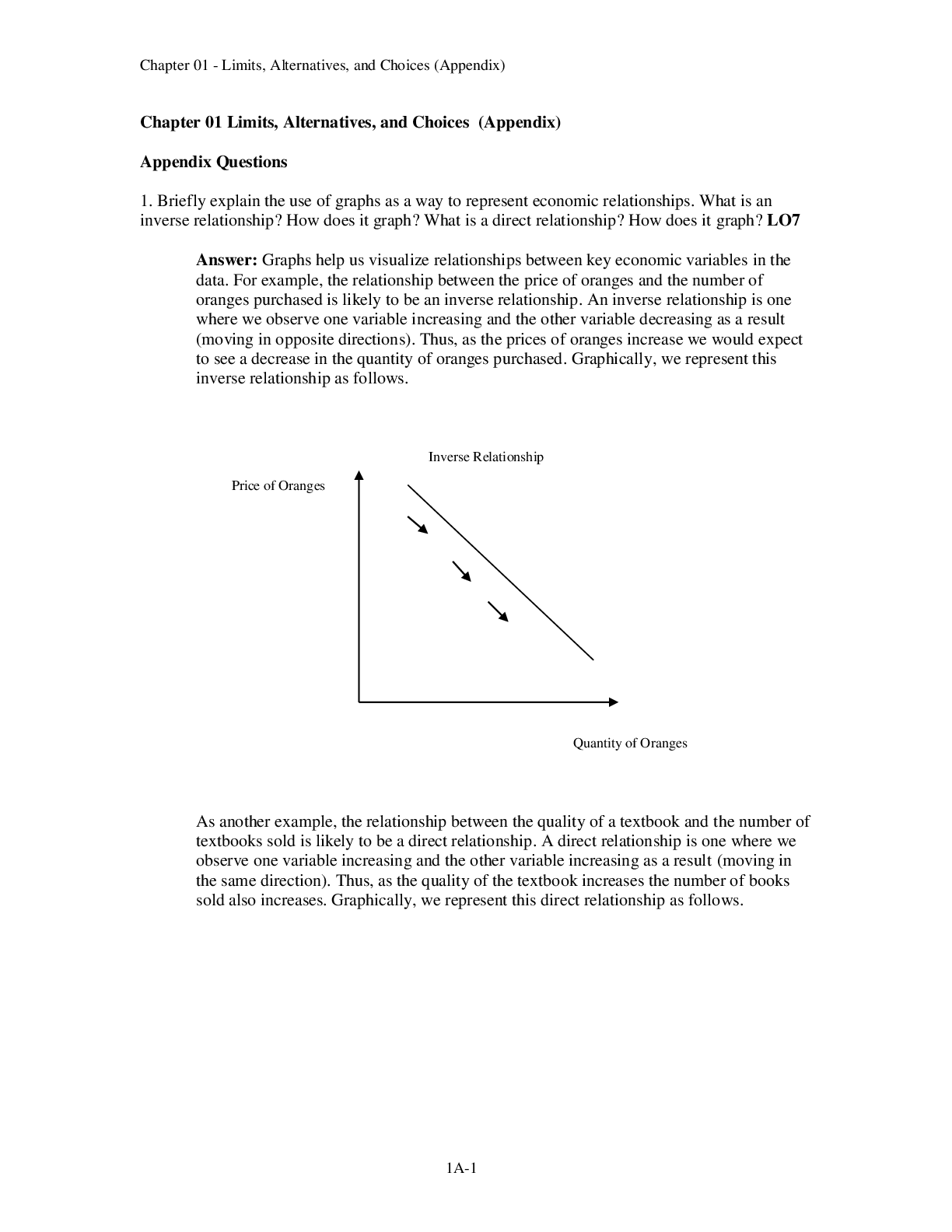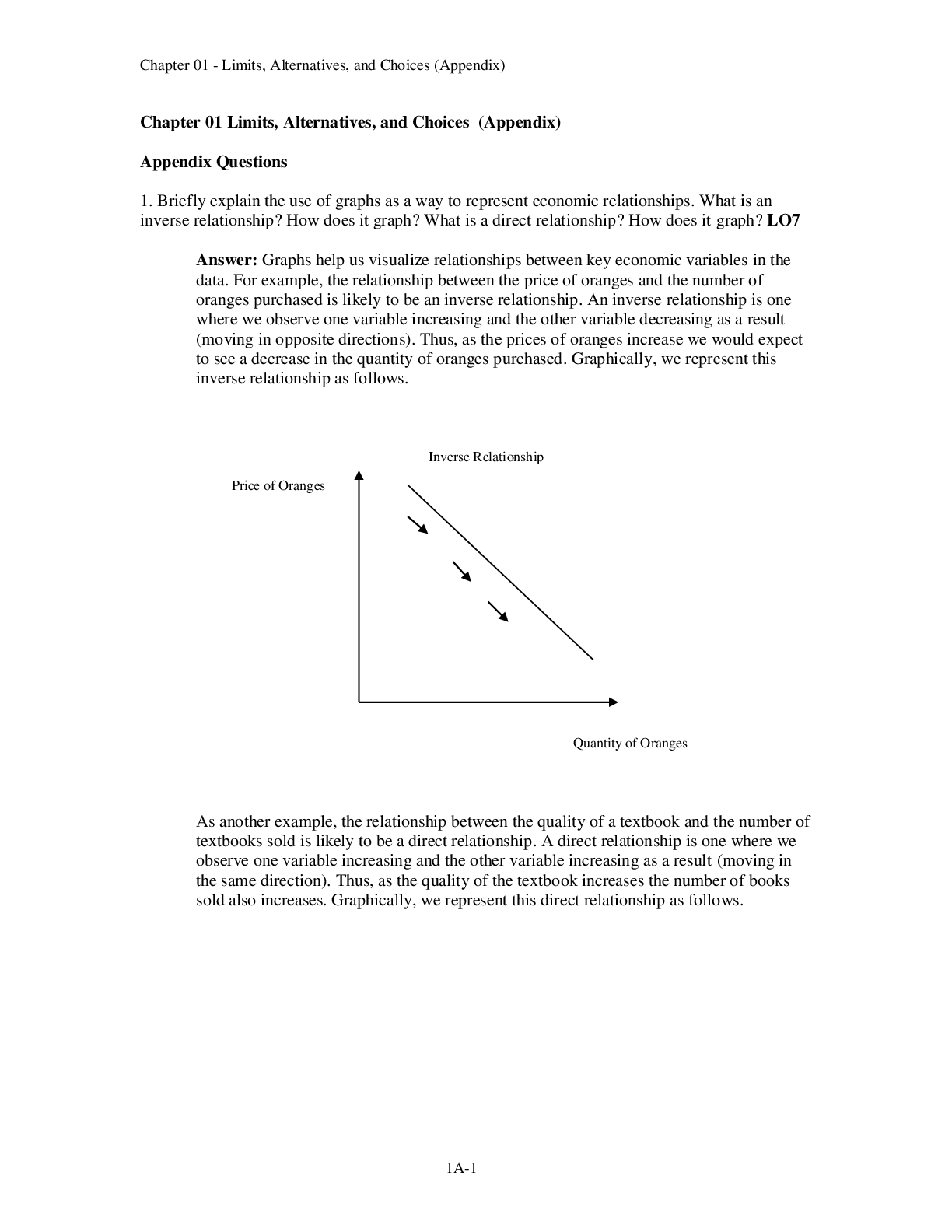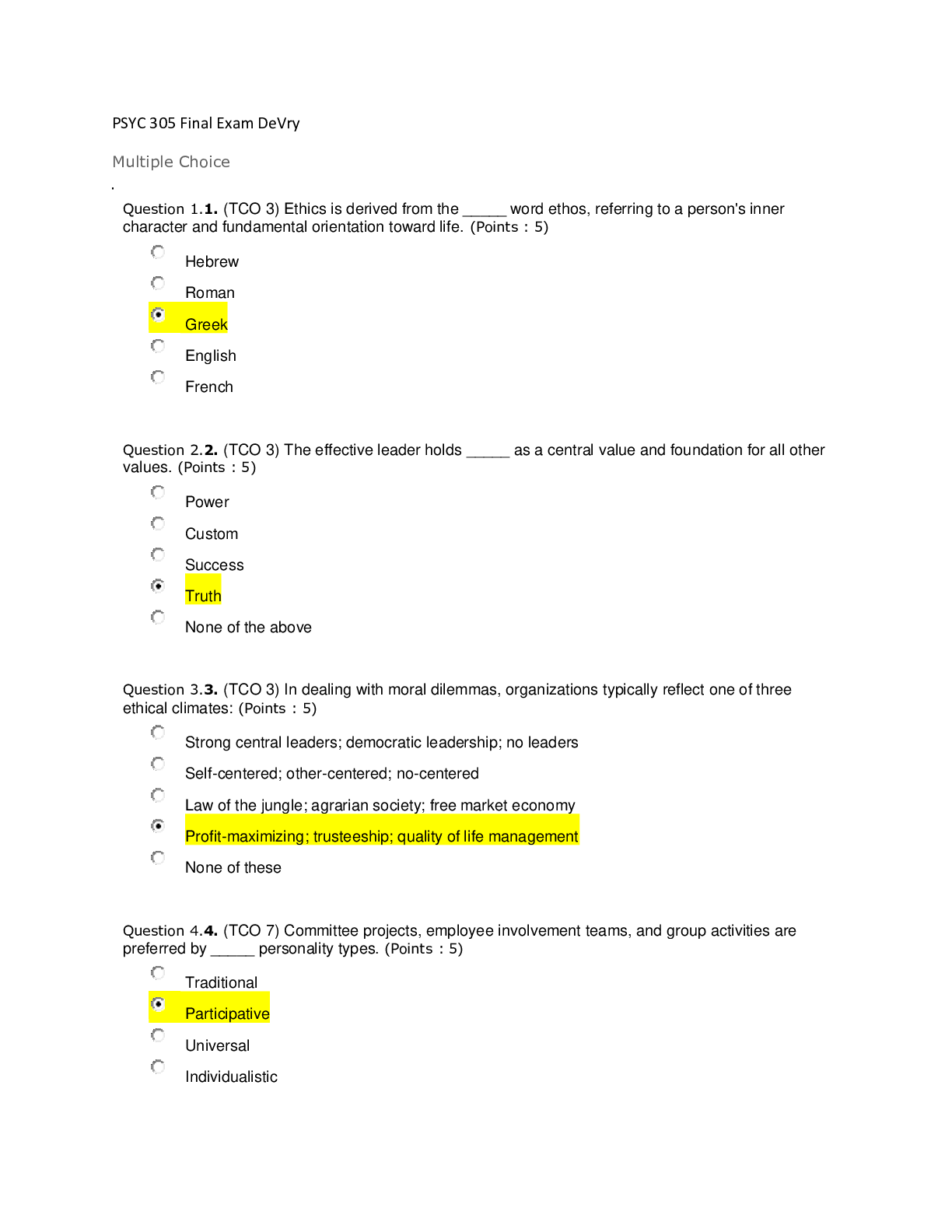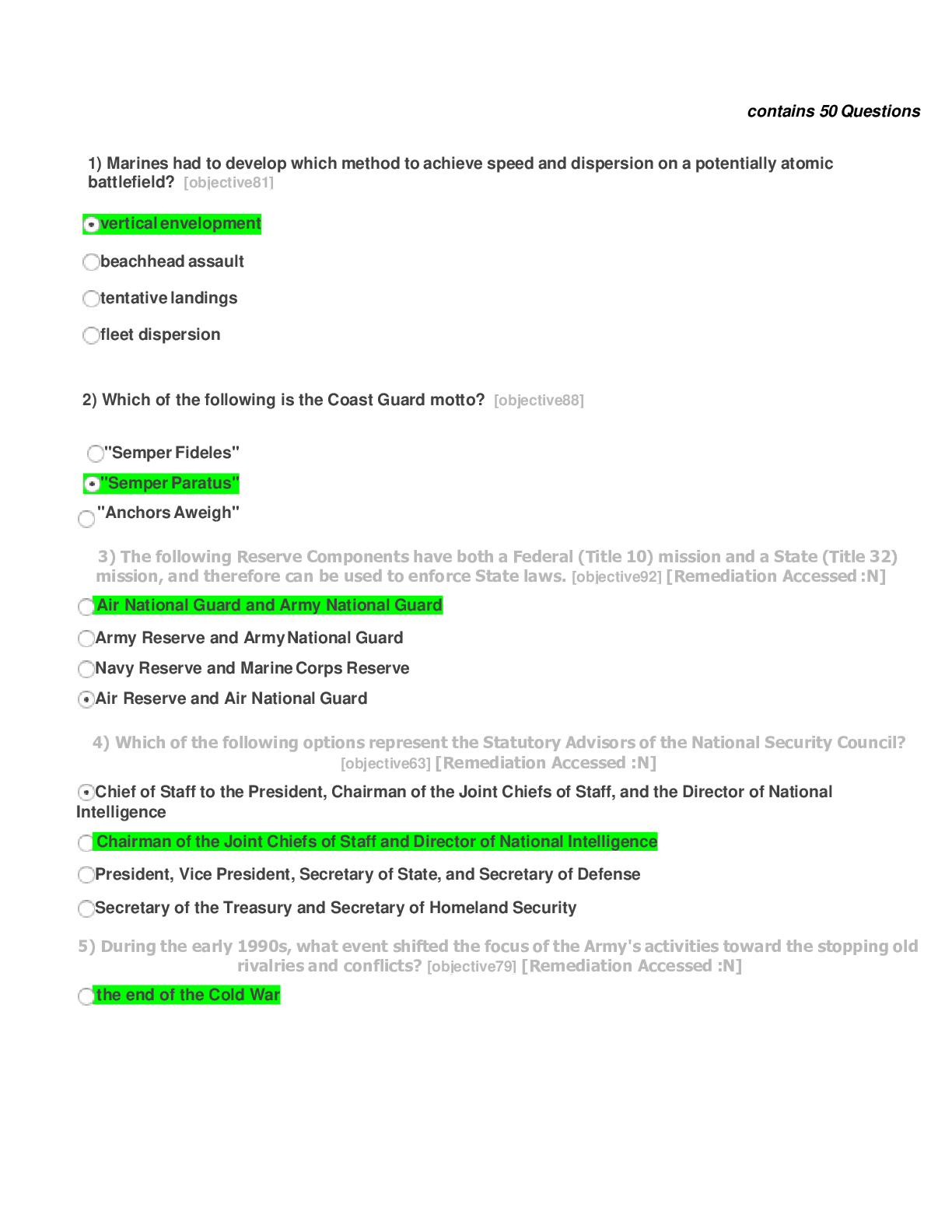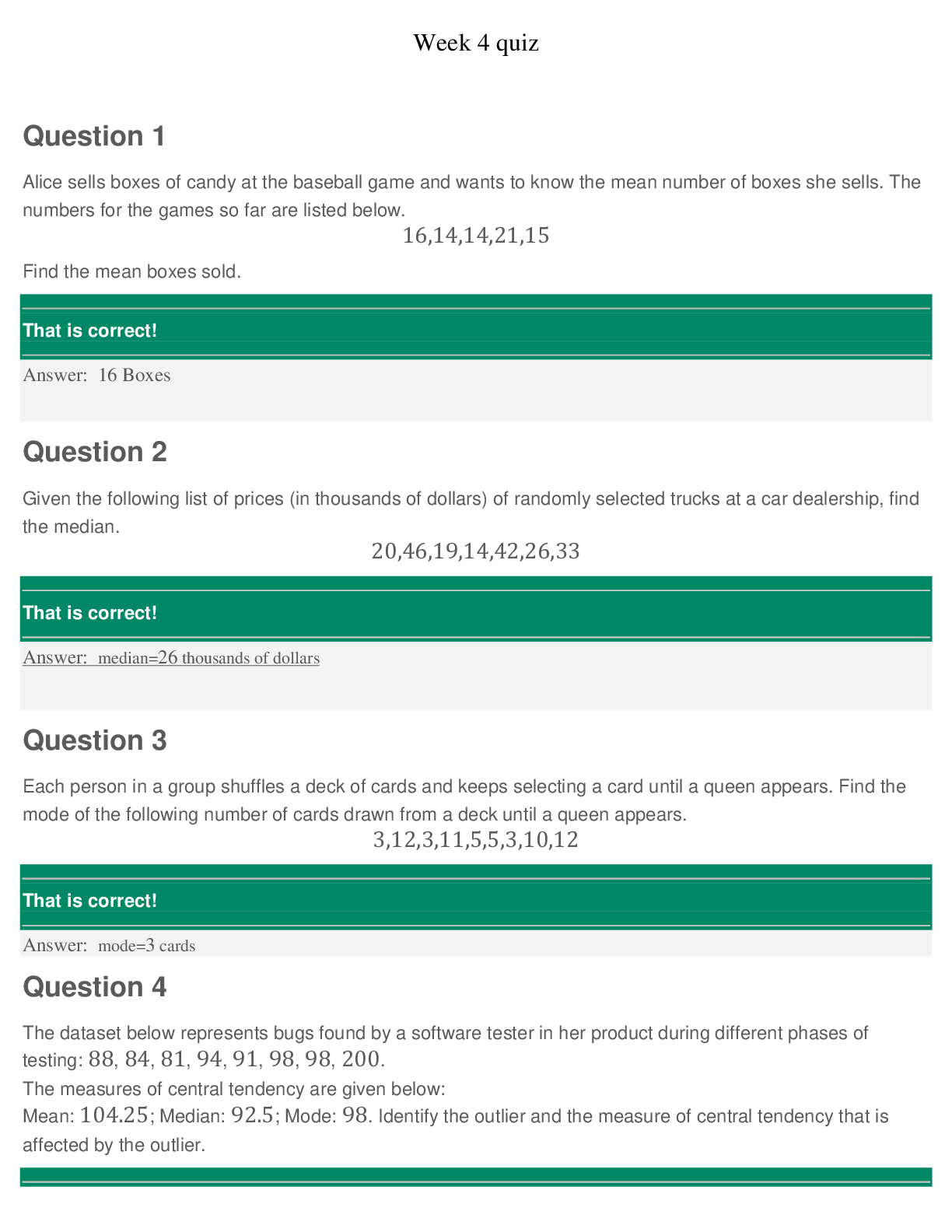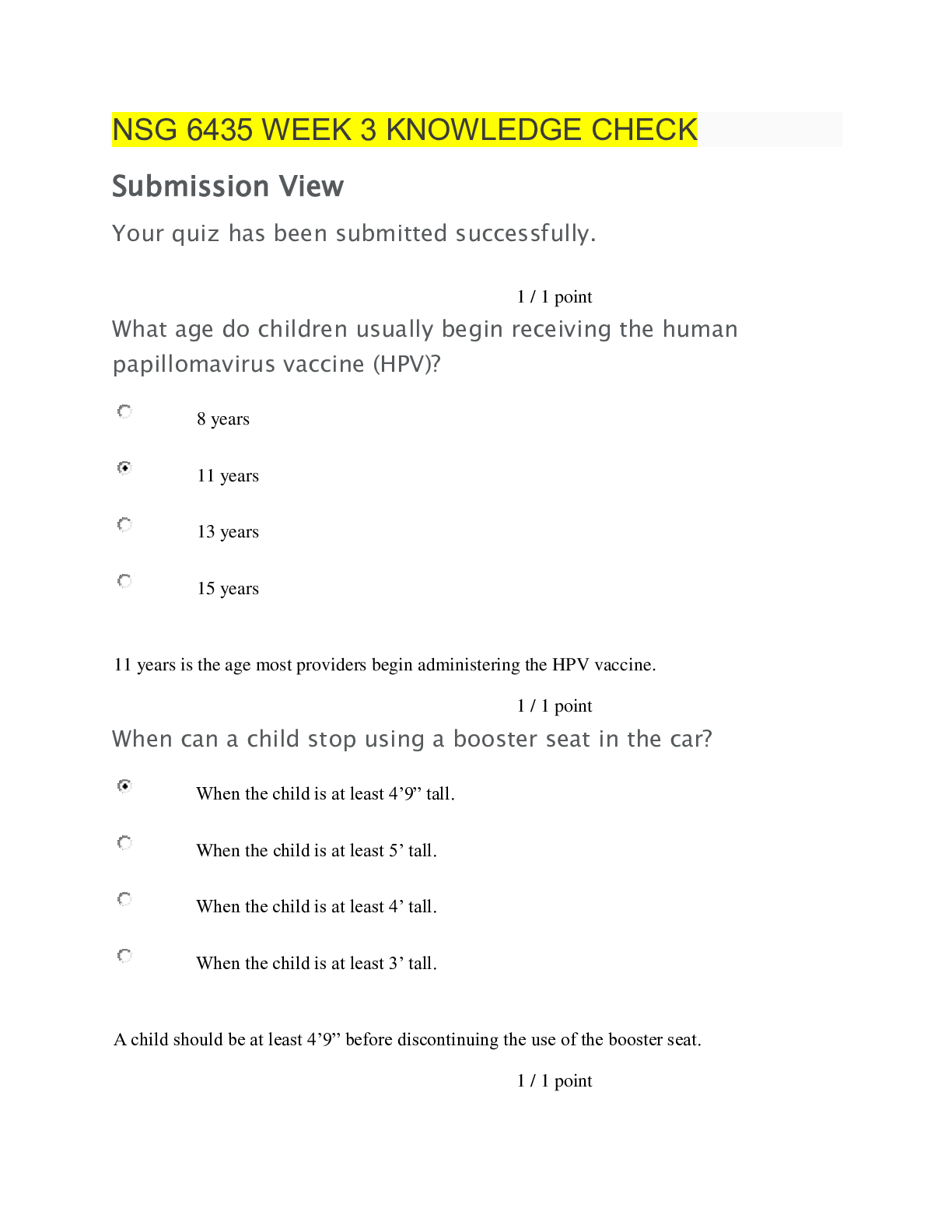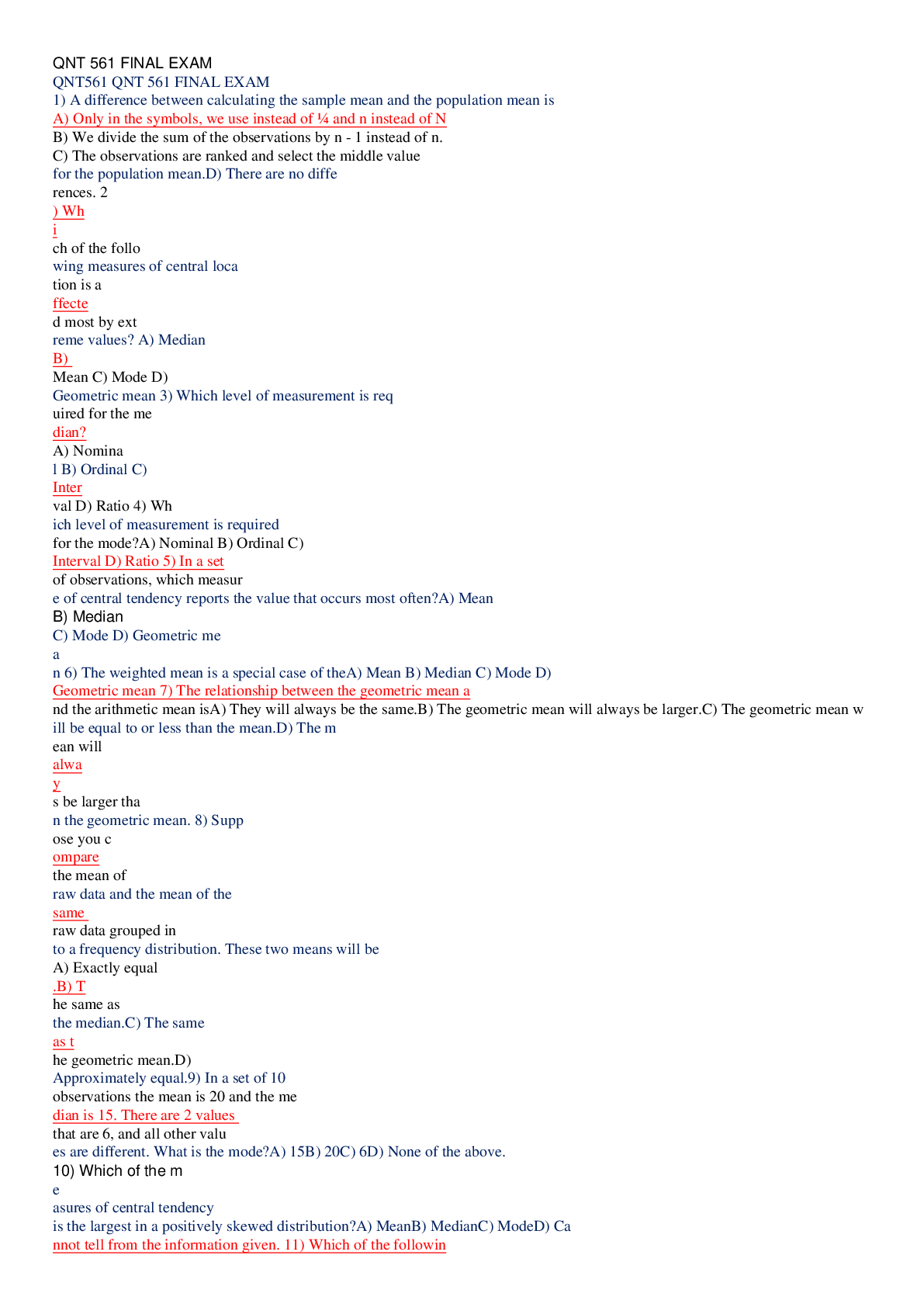*NURSING > EXAM > ATI practice B Questions and Answers | (partner, following findings) | Already Graded A. (All)
ATI practice B Questions and Answers | (partner, following findings) | Already Graded A.
Document Content and Description Below
1. A nurse is assessing a client for manifestations of left-sided heart failure. Which of the following findings should the nurse expect? A: Weight gain B: Enlarged liver C: Distended abdomen D: Coo... l extremities 2. A Nurse is assessing a 6-month-old infant who has bacterial pneumonia. Which of the following Manifestations Should the nurse expect? A: Protruding tongue B: Facial flushing C: Nasal flaring D: Tympany with chest percussion 3. A nurse is caring for a school-age child who was admitted to the emergency department for acute asthma exacerbation. Which of the following actions should the nurse take first? A: Encourage the child to take frequent sips of cool fluids. B: Apply humidified oxygen with a simple mask. C: Start a peripheral access IV. D: Administer an albuterol nebulizer treatment 4. A nurse is providing teaching about foot care to a client who has diabetes mellitus. Which of the following client statements indicates an understanding of the teaching? A: "I'll wash my feet every day with soap and lukewarm water." B: "I'll apply lotion to my feet daily, especially in between my toes." C: "It's okay for me to go barefoot in the house, but not outside." D: "I'll soak my feet every evening before bedtime." 5. A nurse is reviewing the medical record of a client who has decreased urinary output. Which of the following findings should the nurse identify as a risk factor for the development of pyelonephritis? A: Diabetes mellitus B: Radical prostatectomy 2 years ago C: Cholelithiasis D: Taking permethrin to treat pediculosis capitis 6. A nurse is assessing a client who has acute cholecystitis. Which of the following findings should the nurse expect? (Select all that apply.) A: Fever B: Dyspepsia C: Pain radiating to the left shoulder D: Blood-tinged stools E: Eructation 7. A nurse is an emergency department is caring for a client who has appendicitis. Which of the following actions should the nurse take? A: Restrict oral intake to clear fluids. B: Place a heating pad on the client's abdomen. C: Place the client in semi-Fowler's position. D: Administer an enema. 8. A nurse is planning care for a client following collection of admission data. Which of the following findings should the nurse identify as the priority client need? A: The client requests to see a priest for spiritual guidance. B: The client reports coughing and a change of voice whenever he eats. C: The client reports pain immediately following physical therapy. D: The client is worried about financially supporting his family because of his illness. 9. A nurse is caring for a client who has respiratory acidosis due to opioid oversedation. Which of the following actions should the nurse take first? A: Place the client on mechanical ventilation. B: Apply oxygen using a rebreather oxygen mask. C: Ensure a patent airway using a chin-lif t maneuver. D: Administer a reversal agent to the client. 10. A nurse is caring for a group of clients. Which of the following clients should the nurse identify as being at risk for developing respiratory acidosis? A: A client who has a fever B: A client who has abdominal ascites C: A client who is anxious D: A client who is receiving nasogastric suctioning 11. A nurse is providing discharge teaching to the parents of a newborn about crib use. Which of the following statements should the nurse make? A: "Arranging small stuffed animals in the crib is recommended to provide a feeling of security for your baby." B: "Moving the crib near a window in the nursery will provide your baby with necessary fresh air and natural light." C: "Dressing your baby in a one-piece sleeper for bedtime will replace the need to use a blanket or a sheet." D: "Placing your baby on her tummy in the crib will hasten drowsiness and provide a more restful night's sleep." 12. A nurse is reviewing the laboratory results of an adult male client who has hyperlipidemia and is making lifestyle changes to improve his cholesterol levels. Which of the following findings indicates to the nurse that the client has achieved a therapeutic response? A: LDL 168 mg/dL B: HDL 50 mg/dL C: Total cholesterol 268 mg/dL D: Triglycerides 250 mg/dL 13. A nurse is providing teaching to the parent of a school-age child who has a severe bee allergy and a new prescription for an epinephrine auto-injector. Which of the following instructions should the nurse include? A: "Administer the medication into your child's abdomen." B: "Expect your child to sleep for several hours after receiving the medication." C: "Place your child's unused extra syringes in the refrigerator for storage." D: "Give a second injection if the first fails to reverse your child's symptoms." 14. A nurse is caring for a client who is experiencing a panic attack. Which of the following actions should the nurse take? A: Distract the client by having him complete a puzzle. B: Encourage the client to take a deep breath every 2 seconds. C: Administer methylphenidate to the client. D: Stay with the client until manifestations subside. 15. A nurse is preparing to mix NPH insulin and insulin aspart in a single syringe for a client who has type 2 diabetes mellitus. Identify the sequence the nurse should follow. (Move the steps into the box on the right, placing them in the order of performance. Use all Steps.) A: Withdraw the prescribed volume of insulin aspart into the syringe. B: Inject air into the vial equal to the amount of NPH insulin prescribed. C: Withdraw the prescribed volume of NPH insulin into the syringe. D: Inject air into the vial equal to the amount of insulin aspart prescribed 16. A nurse is assessing an 18-month-old toddler who has gastroenteritis with dehydration. The toddler is able to consume 3 mL of oral rehydration solution every 5 minutes but still has emesis and diarrhea. Which if the following medications should the nurse anticipate administering to the toddler? A: Polyethylene glycol B: Bumetanide C: Loperamide D: Ondansetron 17. A nurse is assessing for adverse medication reactions with a client who reports taking more than the recommended dose of acetaminophen for the management of chronic pain. Which of the following findings should the nurse identify as an adverse effect of acetaminophen? A: Elevated aspartate aminotransferase levels B: Decreased skin turgor C: Elevated WBC count D: Decreased audio acuity 18. A nurse is reviewing the laboratory results of a client who is scheduled for surgery and notes a potassium level of 6 mEq/L. Which of the following ECG findings should the nurse expect? A: Heart rate 64/min B: Tall T waves C: Shortened PR interval D: QRS 0.08 seconds 19. A nurse is assessing a 6-month-old infant who has gastroenteritis with mild dehydration. Which of the following findings should the nurse expect? A: Absence of tears when crying B: Loss of 6% of body weight C: Sunken anterior fontanel D: Capillary refill greater than 2 seconds 20. A nurse is assessing a client who has acute pyelonephritis. Which of the following findings should the nurse expect? A: Pain with palpation to the substernal notch B: Urinary burning C: Ecchymosis over the flank D: Radiating pain to the right shoulder 21. A home health nurse is assessing a client who has COPD. The client has a respiratory rate of 22/min and reports shortness of breath. Which of the following actions should the nurse take first? A: Place the client in high-Fowler's position. B: Encourage the client to perform diaphragmatic breathing. C: Instruct the client to perform a huff-coughing technique. D: Administer a nebulized bronchodilator. 22. A nurse is monitoring a client who has metabolic acidosis due to salicylate overdose. For which of the following finding should the nurse monitor? A: Flushed, dry skin B: Seizures C: Hyperreflexia D: Positive Trousseau's sign 23. A nurse is assessing a client who has hypermagnesemia. Which of the following manifestations should the nurse expect? A: Hyperactive deep tendon reflexes B: Abdominal distention C: Bradycardia D: Positive Trousseau's sign 24. A nurse is assessing a client who has an external fixator to the right lower arm following musculoskeletal trauma. Which of the following findings should indicate to the nurse that the client has developed compartment syndrome? A: Serous drainage is present on the pin site dressings B: Flushing of the skin on the right arm C: Bounding pulse palpated in the radial artery D: Numbness to the fingers on the right arm 25. A nurse is reviewing the laboratory records of a client who has AIDS. Which of the following laboratory results should the nurse review to determine if the client is a risk for malnutrition? A: WBC count B: Albumin level C: CD4 T cell count D: C-reactive protein level 26. A nurse is developing a plan of care for a client who is 1 hr postoperative following open carpal tunnel release to treat a musculoskeletal injury. Which of the following interventions should the nurse include in the plan? A: Elevate the client's arm above the heart. B: Apply heat to the client's surgical site. C: Instruct the client to avoid moving their fingers. D: Monitor the client's ability to complete wrist range-of-motion. 27. A nurse is planning discharge teaching for the parent of a newborn. Which of the following information should the nurse include? A: "Cover your newborn with a light blanket while she is sleeping." B: "Do not bathe your newborn immediately after she eats." C: "Place your newborn in a crib with a bumper pad." D: "Wash your newborn's face with a mild soap." 28. A nurse is providing dietary teaching to a client who is a 13 week of gestation and has hyperemesis gravidarum. Which of the following statements should the nurse make? A: "Drink fluids between, rather than with, meals." B: "Eat foods that are served warm." C: "Do not go more than 6 hr between meals." D: "Have a low-protein snack at bedtime." - 29. A nurse is providing teaching to a client who has calcium oxalate renal calculi. Which of the following statements should the nurse include in the teaching? A: "Decrease your calcium intake." B: "You should consume at least 2,400 milligrams of salt per day." C: "Limit the amount of spinach in your diet." D: "Increase your fluid intake to one and a half liters daily." 30. A nurse is assessing a school-age child who has asthma and shortness of breath. Which of the following assessment findings should the nurse identify as the priority? A: Inaudible lung sounds B: Persistent cough C: Yellow zone peak flow meter reading D: Prolonged expiration phase 31. A nurse is providing teaching about home care with an adolescent client who has a skin infection caused by methicillin-resistant Staphylococcus aureus (MRSA). Which of the following client statements indicates an understanding of the teaching? A: "I will soak in a bathtub filled one-fourth full of water with one-half cup of bleach." B: "I will wash my clothes in cold water and detergent." C: "I will throw away my razor after using it three times." D: "I will apply imiquimod cream to the lesions before going to bed each night." 32. A nurse is providing teaching about home care to the parent of an adolescent who has infectious mononucleosis. Which of the following manifestations should the nurse instruct the parent to report to the provider? A: Swollen cervical lymph nodes B: Exudate on tonsils C: Lack of energy D: Onset of abdominal pain 33. A nurse is caring for a client who is experiencing an asthma attack. Which of the following procedures should the nurse use to assess the client's respiratory status? A: Peak expiratory flow meter testing B: Spirometry monitoring C: Pulmonary function testing D: Chest x-ray 34. A nurse is teaching a client who has a new diagnosis of peripheral neuropathy about foot care. Which of the following statements should the nurse include? A: "Wear open-toe shoes to allow air to circulate around your feet." B: "Use a heating pad set on low to warm your feet when they feel cold." C: "File your toenails straight across to prevent ingrown toenails." D: "Apply a thin layer of lotion between your toes twice per day." 35. A nurse is assessing a client for manifestations of heat stroke. Which of the following findings should the nurse expect? A: Hypertension B: Somnolence C: Oliguria D: Bradycardia 36. A nurse is assessing a client who is experiencing diarrhea and vomiting and has a sodium level of 124 mEq/L. Which of the following manifestations should the nurse expect? A: Orthostatic hypotension B: Hoarse voice C: Neck vein distention D: Muscle twitching 37. A nurse is assessing a client whose parent recently died. The nurse should identify that which of the following findings places the client at risk for maladaptive grieving? A: The client lost his house in a house fire 1 month ago. B: The client has retired after 30 years of employment. C: The client's parent was an older adult. D: The client's parent had a chronic terminal illness 38. A nurse is providing teaching about home care to the parent of a child who has pediculosis capitis. Which of the following information should the nurse include? A: Soak the child's combs and brushes in hot water for 5 min. B: Rinse the child's hair each day with 236.5 mL (1 cup) of vinegar. C: Seal the child's nonwashable toys in plastic bags for 7 days. D: Comb the child's hair daily with an extra fine-tooth comb. 39. A nurse is providing teaching about home care with the parent of a child who has scabies. Which of the following statements by the parent indicates an understanding of the teaching? A: "I should apply the cream only to the areas where there is a rash." B: "I should wash my child's bed linens and clothing in hot water and detergent." C: "I should expect my child's rash to go away within 72 hours after starting treatment." D: "I should leave the cream on my child for 4 hours before washing it off." 40. A nurse is assessing a client who has peripheral arterial disease. Which of the following findings should the nurse expect? A: Brown discoloration of the lower extremities B: Superficial ulcer on the medial aspect of the ankle C: Dependent rubor D: Telangiectasias 41. A nurse is providing teaching to a client who has a methicillin-resistant Staphylococcus aureus (MRSA) skin infection. Which of the following client statements indicates an understanding of the management of antibiotic resistant infections? A: "I will keep the infected area open to air to help it heal." B: "I can sleep in the same bed as my partner after I have been taking antibiotics for 24 hours." C: "I should sit on upholstered chairs instead of hardback chairs." D: "I will wash all uninfected skin areas with a fresh washcloth." 42. A nurse is assessing an infant whose guardian reports, "My baby has been crying nonstop, has a fever, and has been pulling at her ear." Which of the following manifestations should the nurse expect for an infant who might have otitis media? A: Enlarged postauricular lymph nodes B: Increased flatulence with constipation C: Indicates a desire to suck more frequently D: Slow bounding heart rate 43. A nurse is assessing a client who has hyperthyroidism and has been taking methimazole for 6 months. Which of the following findings indicates a therapeutic response to the medication? A: The client's skin is warm and moist. B: The client reports sleeping longer during the night. C: The client is experiencing increased bowel movements. D: The client's weight is 1.4 kg (3.1 lb) less than baseline 44. A nurse is reviewing the laboratory results of an adult client who has metabolic alkalosis. Which of the following findings should the nurse expect? A: Calcium 9.5 mg/dL B: Bicarbonate 23 mEq/L C: Potassium 3 mEq/L D: pH 7.4 45. A nurse is reviewing a client's medical record prior to a laparoscopic appendectomy. Which of the following findings should the nurse report to the provider? A: Prothrombin time 12 seconds B: History of sinusitis several times each year C: BMI of 24 D: Report of urinating small amounts twice daily 46. A nurse is caring for a client who has severe hypothermia. Which of the following actions should the nurse take? A: Place the client in semi-Fowler's position. B: Administer IV pain medication if the client is having extremity pain. C: Heat the client's body by using external rewarming devices. D: Contact a specialized team to place the client on cardiopulmonary bypass. 47. A nurse is caring for a client who has developed cellulitis in a lower extremity. Which of the following actions should the nurse take? A: Apply warm dry packs initially then apply cool moist packs to the lower extremity. B: Elevate the extremity 7.6 to 15.2 cm (3 to 6 in) above heart level. C: Gently massage the affected extremity for 10 to 15 min every shift. D: Apply a topical corticosteroid to any open areas on the affected extremity twice per day 48. A nurse is teaching a group of newly licensed nurses about hypothermia and the care of a client who has frostbite to the fingers and toes from cold exposure. Which of the following information should the nurse include in the teaching about frostbite? A: Slowly institute rewarming of the affected areas. B: Place the affected areas of frostbite in a warm water bath. C: Massage the affected areas of frostbite. D: Position the affected areas of frostbite flat after warming 49. A nurse is teaching about clonazepam with a young adult female client who has generalized anxiety disorder. Which of the following statements should the nurse include in the teaching? A: "You can safely continue taking this medication if you become pregnant." B: "This medication could cause you to have thoughts of self-harm." C: "You should take this medication 1 hour before eating." D: "Take this medication with an antacid if stomach upset occurs." 50. A nurse is assessing a client who is receiving intravenous medications. Which of the following findings should the nurse identify as a manifestation of respiratory acidosis? A: Confusion B: Flushed, moist skin C: Hyperreflexia D: Bounding peripheral pulses 51. A nurse is planning discharge for a postpartum client. The client tells the nurse she is having a subdermal implant placed for contraception at her 6-week follow-up examination and ask about the adverse effects of the implant. Which of the following manifestations should the nurse include? A: Irregular bleeding B: Fatigue C: Shoulder pain D: Recurrent urinary tract infections (UTIs) 52. A nurse is teaching a group of newly licensed nurses about risk factors for peptic ulcers. Which of the following risk factors should the nurse include in the teaching? A: Bacterial infection with Escherichia coli B: Long-term use of NSAIDs C: Frequent use of proton pump inhibitors D: A diet that includes spicy foods 53. A nurse is assessing a client who has generalized anxiety disorder and has been practicing adaptive use of coping mechanisms. Which of the following responses indicates the client's adaptive use of suppression? A: "I teach my children about healthy eating because my anxiety makes me want to overeat." B: "I started taking kickboxing classes to release the stress I feel from work." C: "I avoid thinking about problems that worry me until I have time to focus on a solution." D: "I let my partner choose the movie for date night since I yelled at him when I was stressed." 54. A nurse is providing teaching to a client who has osteoporosis. Which of the following information should the nurse include in the teaching? A: Increase daily intake of foods containing vitamin A. B: Limit alcohol consumption to 10 oz daily. C: Perform exercises to strengthen the abdominal core. D: Start a daily jogging regimen 55. A nurse in an emergency department is reviewing the laboratory report of a client who has hyperventilation. The client's ABG results are pH 7.50, PaCo2 29 mmHg, and HCO3 25 following acid-base imbalances? A: Metabolic alkalosis B: Metabolic acidosis C: Respiratory alkalosis D: Respiratory acidosis 56. A nurse is caring for a client who is experiencing a hyperglycemic-hyperosmolar state related to complication of diabetes mellitus. Which of the following findings should the nurse expect? A: Fruity-scented breath B: Serum glucose 350 mg/dL C: pH 7.32 D: Hypotension 57. A nurse is teaching a client who recently lost his partner to a terminal illness. The client asks how his 4-year-old son is expected to react to the death of his partner. Which of the following information should the nurse include in the teaching? A: A preschooler has no concept of death. B: A preschooler is often interested in what happens to the body after death. C: A preschooler often believes that death is reversible. D: A preschooler understands that death happens to everyone. 58. A nurse in a community health clinic is reviewing data from the medical records of four clients. Which of the following communicable diseases requires reporting by the nurse? A: Gonorrhea B: Herpes genitals C: Human papillomavirus D: Bacterial vaginosis 59. A nurse is providing teaching about exercise to a client who has osteoarthritis. Which of the following information should the nurse include? A: Apply heat to the joints following exercise. B: Avoid aerobic exercises such as biking. C: Perform exercise even on days when joints are painful. D: Household chores can count as exercise 60. A nurse is performing a focused assessment on a client who has cholelithiasis and reports pain. Which of the following areas should the nurses assess? (You will find hot spots to select in the artwork below. Select only the hot spot that corresponds to your answer.) A: Upper Right Quadrant B: Lower Left Quadrant C: Lower Right Quadrant 61. A nurse is reviewing the medical record of a client who is receiving total parenteral nutrition for a malabsorption disorder. Which of the following findings should the nurse identify as an indication that the client's nutritional status is improving? A: Intake of fluid is less than output of urine over the past 2 days B: 1 kg (2.2 lb.) weight gain over the past 2 days C: Blood glucose 206 mg/dL D: Prealbumin 13 mg/dL 62. A nurse is reviewing the medical record of a client who has AIDS and is experiencing anorexia. Which of the following medications should the nurse expect the provider to prescribe to reduce the client's risk of failure to thrive? A: Megestrol B: Ondansetron C: Famotidine D: Pancrelipase 63. A nurse is assessing a client who has renal calculi. For which of the following findings should the nurse notify the provider immediately? A: Flank pain with radiation toward the scrotum B: 150 mL emesis C: Oliguria with bladder distention D: Blood pressure 160/90 mm Hg 64. A nurse is reviewing the laboratory report of a client who is taking atorvastatin. Which of the following findings should the nurse identify as an indication that the medication is having an adverse effect? A: LDL 100 mg/dL B: Total cholesterol 199 mg/dL C: Aspartate aminotransferase (AST) 45 units/L D: Creatine kinase (CK) 120 units/L 65. A hospice nurse is visiting with a client following the death of her partner 1 month ago. The client is tearful and states she does not see how she can ever be happy again. Which of the following responses should the nurse make? A: "You're sad now, but the grief will pass eventually." B: "You should attend a grief support group to see how others cope with loss." C: "What are some of the best times with your partner that you remember?" D: "How are other members of the family managing?" 66. A nurse is reviewing the medical record of a client who has age-related macular degeneration (AMD). Which of the following findings should the nurse identify as a risk factor for the visual impairment? A: Male sex B: Hypertension C: Chronic obstructive pulmonary disease D: Osteoporosis 67. A nurse is developing a plan of care for a client who is scheduled to have an induction of labor due to a fetal demise. Which of the following actions should the nurse include? A: Limit the amount of time the client spends with the newborn after birth. B: Discourage the client from having other family members see the newborn. C: Inform the client that an autopsy of the newborn is required by federal law. D: Bathe, diaper, and dress the child before bringing the newborn to the client. 68. A nurse is teaching a client who has hypokalemia about nutrition management. Which of the following fruits should the nurse recommend as the best source of potassium? A: One small apple B: One-half cup of sweet cherries C: One-half cup of fresh pineapple D: One small orange 69. A nurse is caring for a client who has renal calculi and is taking oxybutynin for pain. Which of the following findings should the nurse identify as an adverse effect of the medication? A: Increased salivation B: Bradycardia C: Tinnitus D: Distended bladder 70. A nurse is assessing a client who has gestational diabetes and ketoacidosis. Which of the following manifestations should the nurse expect? A: Increased urination B: Sweating C: Dizziness D: Loose stools 71. A nurse is providing teaching to a client about preventing hearing loss from trauma. Which of the following instructions should the nurse include in the teaching? A: "Keep your mouth open when sneezing." B: "Block one nostril when blowing your nose." C: "Use an ear wick candle to remove excess cerumen from the canal." D: "Lubricate cotton-tipped applicators with mineral oil to clean the ear canal." 72. A nurse is assessing a client who has a partial obstruction of the large bowel. Which of the following manifestations should the nurse expect? A: Presence of peristaltic waves B: Epigastric distention C: Large amounts of emesis of fecal material D: Ribbon-like stools 73. A nurse is reviewing the laboratory results of a client who is taking sulfasalazine to treat ulcerative colitis. Which of the following laboratory findings should the nurse identify as an adverse effect of sulfasalazine? A: Total bilirubin 0.8 mg/dL B: WBC count 4,000/mm3 C: Platelets 190,000/mm3 D: Creatinine 1 mg/dL 74. A nurse is providing dietary teaching for a client who has GERD. The nurse should instruct the client to avoid which of the following items? A: Caffeinated coffee B: Shellfish C: Apple juice D: Green beans 75. A nurse is assessing a client in the triage room of an emergency department. Based on the client findings, which of the following actions should the nurse take? (Click on the "Exhibit" button for additional information about the client. There are three tabs that contain separate categories of data.) Exhibit 1: Nurses' Notes Medical history of type 2 diabetes mellitus and hypertension. Reports weight loss, lethargy, and night sweats over the last 3 weeks. Cough with hemoptysis. Client traveled overseas 3 months prior. Exhibit 2: Graphic Record Blood pressure 110/62 mm Hg Heart rate 90/min Respiratory rate 24/min SaO2 95% Temperature 38.1° C (100.6° F) Exhibit 3: Diagnostic Results Casual blood glucose 132 mg/dL A: Inform the client she will require an IV fluid bolus. B: Perform rapid influenza testing. C: Place a surgical mask on the client. D: Request a prescription for a single dose of short-acting insulin 76. A nurse is assessing a client who has developed Clostridium difficile as an adverse effect to ciprofloxacin. Which of the following medications should the nurse expect the provider to prescribe the treat the C. difficile? A: Vancomycin B: Magnesium hydroxide C: Rifampin D: Metoclopramide 77. A nurse in a provider's office is reviewing the medical record of a client who has COPD. Which of the following findings is a priority for the nurse to report to the provider? A: Chest x-ray results show increased lung space. B: Sputum culture shows gram positive bacteria. C: SpO2 level is 88%. D: Weight loss of 1.4 kg (3 lb) since prior visit. 78. A nurse is providing discharge teaching to a client about managing diverticulitis. Which of the following statements should the nurse include in the teaching? A: "Use bisacodyl suppositories to stimulate a bowel movement." B: "Avoid lifting objects greater than 50 pounds." C: "Consume a clear liquid diet until symptoms resolve." D: "Take a probiotic 15 minutes after taking a prescribed antibiotic to prevent antibiotic-related diarrhea." 79. A nurse is teaching about ezetimibe with a client who has hyperlipidemia. Which of the following client statements indicates an understanding of the teaching? A: "I should avoid taking this medication with milk." B: "I will return to have my cholesterol levels checked in 2 weeks." C: "I can expect to lose weight while taking this medication." D: "I understand that muscle tenderness is an expected result of this medication." 80. A nurse is assessing a client who has musculoskeletal trauma following a motor-vehicle crash 2 days ago. Which of the following findings should the nurse report to the provider? Exhibit 1: Diagnostic Results Hct 42% Hgb 14 g/dL ECG Sinus tachycardia Exhibit 2: Graphic Record Temperature 38.3°C (100.9°F) Heart rate 106/min Respiratory rate 22/min Blood pressure 144/90 mm Hg Exhibit 3: Nurses' Notes Client reports pain level of 8 on a scale of 0 to 10 in casted left arm IV morphine administered 45 min ago Client is diaphoretic and anxious A: Laboratory results B: Blood pressure C: Pain report D: ECG results 81. A nurse is providing discharge teaching for a client who has a new diagnosis of COPD. Which of the following client statements indicates an understanding of the teaching? A: "I will quickly complete my household errands in the morning before taking a break." B: "I will breathe out slowly through pursed lips if I feel short of breath." C: "I will try to eat three large meals every day." D: "I will not get a flu shot because I might get an infection." 82. A nurse is evaluating a client's understanding of dietary teaching to treat hyperlipidemia. Which of the following menu choices indicates an understanding of the teaching? A: A black bean burger on a whole grain bun B: Oatmeal with whole milk C: A baked potato with butter D: A pork sausage patty on a biscuit 83. A nurse is caring for a client who has right-sided hemiparesis following a stroke. Which of the following images is an indication that the nurse is correctly assisting the client to ambulate? A: Nurse on the left holding client's arm B: Nurse on the right holding gait belt C: Nurse in the front holding walker D: Nurse on the left holding gait belt 84. A nurse is participating in a health fair by providing screenings for osteoporosis. Which of the following should the nurse recognize as a risk factor for the disease? A: BMI 26 or above B: Excessive sun exposure C: Frequent weight-bearing exercise D: Hip fracture 6 months ago 85. A nurse is assessing a newly admitted client who has an intense fear of heights. Which of the following clinical names for this fear should the nurse document in the client's medical record? A: Agoraphobia B: Xenophobia C: Acrophobia D: Glossophobia 86. A nurse is caring for a client who has possible appendicitis. Which of the following actions should the nurse take? A: Palpate the left lower quadrant of the abdomen to check for rebound pain. B: Start IV fluid replacement. C: Treat the client's pain with oral opioid analgesics given with food. D: Administer a suppository to the client in preparation for surgery. 87. A nurse is assessing a preschool-age child who has chickenpox. The parent asks the nurse how to treat the child's fever. Which of the following responses should the nurse make? A: "Avoid giving aspirin to your child." B: "Place your child in a cool bath for 20 minutes twice per day." C: "Lower the room temperature to stimulate shivering." D: "Give eight doses of acetaminophen in 24 hours according to the child's weight." 88. A nurse is preparing to administer medication to a client who has a history of hypertension. The nurse should identify that which of the following is administered for antihypertensive therapy? A: Ginkgo biloba B: Digoxin C: Hydrochlorothiazide D: Acetaminophen 89. A nurse is planning teaching for an adolescent who has exercise-induced asthma and has new prescriptions for cromolyn and albuterol inhalers. Which of the following instructions should the nurse plan to include in the teaching? A: Inhale the second puff of cromolyn 2 min after the first. B: Use the cromolyn following exercise if shortness of breath occurs. C: Use the albuterol prior to planned exercise. D: Cleanse the albuterol mouthpiece once every 2 weeks. 90. A nurse is admitting an infant who has pertussis. Which of the following actions should the nurse take? A: Administer an antiviral medication to the infant. B: Initiate droplet precautions for the infant. C: Limit the infant's oral intake of fluids to 60 mL/hr. D: Monitor the infant for manifestations of increased intracranial pressure 91. A nurse in a provider's office is assessing a client who is taking warfarin to treat atrial fibrillation. Which of the following findings should the nurse identify as an adverse effect that should be reported to the provider? A: Black, tarry stools B: Ringing in the ears C: Urinary retention D: Recent hallucinations 92. A nurse on a pediatric unit is preparing an in-service for coworkers about failure to thrive in infants. Which of the following risk factors should the nurse include? A: Congenital hypothyroidism B: Meconium staining at birth C: Macrosomic at birth D: Congenital heart disease 93. A nurse is assessing a client for manifestations of GERD. Which of the following findings indicates to the nurse that the client might have GERD? A: Decreased salivation B: Diarrhea C: Tonsillitis D: Globus 94. A nurse is providing teaching for a client following cataract surgery. Which of the following statements indicates to the nurse that the client understands the teaching? A: "I will have my best vision 3 weeks after my surgery." B: "I should report a creamy white discharge from my eye to my doctor." C: "I will avoid getting water in my eyes until the second day after surgery." D: "I should avoid using the vacuum cleaner for several weeks." 95. A nurse is assessing a client who has deep-vein thrombosis (DVT) in the right lower extremity. Which of the following findings on the affected extremity should the nurse expect? A: Coolness B: Hyperpigmentation C: Swelling D: Distended, tortuous veins 96. A nurse in an emergency department is assessing a client who displays manifestations of a small bowel obstruction. Which of the following findings should the nurse expect? (Select all that apply.) A: Abdominal distention B: Flank pain C: Hypervolemia D: Vomiting E: Hyperactive bowel sounds 97. A nurse is admitting a client who has peptic ulcer disease and an upper gastrointestinal bleed. Which of the following manifestations should the nurse expect? (Select all that apply.) A: Dark, tarry stools B: Bright red emesis C: Increased heart rate D: Increased blood pressure E: Bounding peripheral pulses 98. A nurse is reviewing the laboratory results of a client who is receiving gentamicin for the treatment of an infection related to renal calculi. Which of the following findings should the nurse report immediately to the provider? A: Potassium level 4.2 mEq/L B: WBC count 10,000/mm3 C: Magnesium 2 mEq/L D: Creatinine 2.5 mg/dL 99. A nurse is caring for a client who has pneumonia. Which of the following actions is the priority for the nurse to take? A: Monitor intake and output. B: Provide teaching about antibiotic therapy. C: Administer the influenza vaccine. D: Observe the client perform incentive spirometry 100. A nurse is assessing a client who has generalized anxiety disorder and is experiencing a moderate level of anxiety. Which of the following manifestations should the nurse expect? A: Focuses on the source of the anxiety B: Exhibits an inability to speak C: Experiences auditory hallucinations D: Feels surroundings are unreal 101. A nurse is caring for a client who has a deep-vein thrombosis and is receiving heparin via continuous IV infusion. The client has a positive fecal occult blood test and abdominal tenderness upon palpation. Which of the following prescriptions should the nurse expect the provider to prescribe? A: Vitamin K B: Protamine sulfate C: Flumazenil D: Acetylcysteine 102. A nurse is teaching a client who has COPD about preventing pneumonia. Which of the following client statements indicates an understanding of the teaching? A: "I will drink one and a half liters of fluids every day." B: "I will get the pneumonia vaccine yearly." C: "I will spray an aerosol disinfectant in my house every day." D: "I will wash my hands whenever I come home from the grocery store." 103. A nurse is assessing a client for manifestations of right-sided heart failure. Which of the following findings should the nurse expect? A: Jugular vein distention B: Fatigue C: Angina D: Hacking cough 104. A nurse is planning discharge teaching for the guardian of a child who had a cardiac catheterization. Which of the following instructions should the nurse include? A: Monitor the site daily for drainage. B: Leave the pressure dressing on for 48 hr. C: Administer aspirin if the child reports pain. D: Resume tub baths in 24 hr. 105. A nurse is reviewing a client's home medication list during admission to a long-term care facility. The nurse should identify that the client takes which of the following medications to manage osteoarthritis? (Select all that apply.) A: Lidocaine 5% patches B: Celecoxib C: Vancomycin D: Cyclobenzaprine E: Glucosamine 106. A nurse is counseling a client who recently lost her partner in a motor-vehicle crash. Which of the following reactions should the nurse identify as a part of the second stage of the grieving process? A: Persistent feelings of hopelessness B: Loss of self-esteem C: Chronic physical manifestations D: Feeling anger toward family members 107. A nurse is caring for a client who has generalized anxiety disorder. Which of the following medications should the nurse plan to administer? A: Methylphenidate B: Escitalopram C: Varenicline D: Lithium carbonate 108. A nurse is conducting a visual assessment for a client who is at risk for developing glaucoma. Which of the following should the nurse identify as a risk factor for this condition? A: Heredity B: Gender C: Anemia D: Hypoglycemia 109. A nurse is assessing a client who has a new diagnosis of hypothyroidism. Which of the following manifestations should the nurse expect? A: Cold intolerance B: Diaphoresis C: Weight loss D: Tachycardia 110. A nurse is providing teaching for a client who has peripheral neuropathy of the lower extremities. Which of the following client statements indicates an understanding of the teaching? A: "I should wash my feet with soap before I try to treat my calluses." B: "I should limit wearing the same shoes 2 days in a row." C: "I should use home remedies to treat any blisters or sores on my feet." D: "I should use adhesive tape to secure a dressing on my foot when I have skin breakdown." [Show More]
Last updated: 1 year ago
Preview 1 out of 33 pages

Buy this document to get the full access instantly
Instant Download Access after purchase
Add to cartInstant download
We Accept:

Reviews( 0 )
$14.50
Document information
Connected school, study & course
About the document
Uploaded On
Oct 16, 2021
Number of pages
33
Written in
Additional information
This document has been written for:
Uploaded
Oct 16, 2021
Downloads
0
Views
63






.png)









